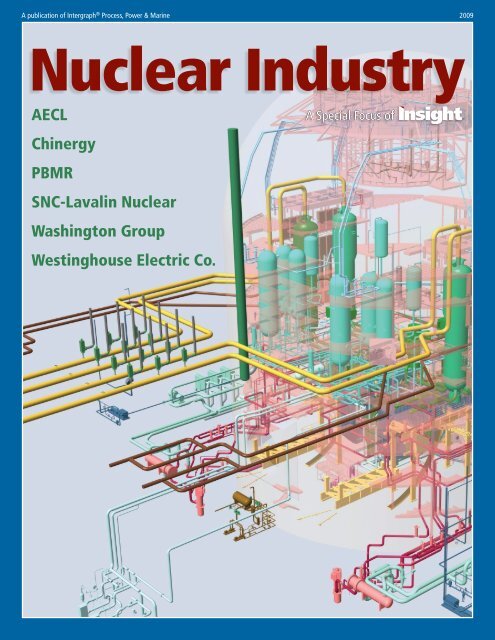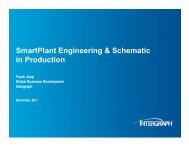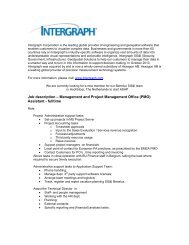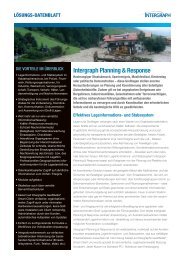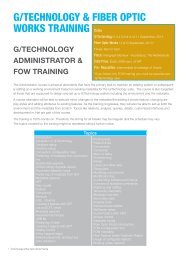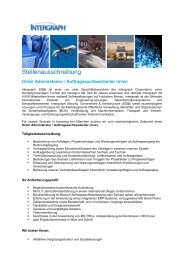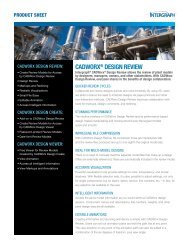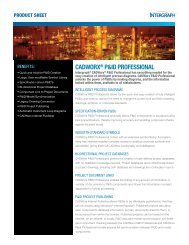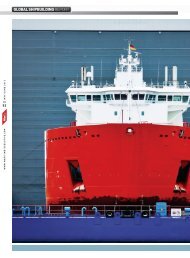Read the Nuclear Industry Spotlight - Intergraph
Read the Nuclear Industry Spotlight - Intergraph
Read the Nuclear Industry Spotlight - Intergraph
Create successful ePaper yourself
Turn your PDF publications into a flip-book with our unique Google optimized e-Paper software.
A publication of <strong>Intergraph</strong> ® Process, Power & Marine<br />
2009<br />
<strong>Nuclear</strong> <strong>Industry</strong><br />
AECL<br />
A Special Focus of<br />
Chinergy<br />
PBMR<br />
SNC-Lavalin <strong>Nuclear</strong><br />
Washington Group<br />
Westinghouse Electric Co.
Perspective: Westinghouse Electric Co.<br />
A Resurgence in Commercial <strong>Nuclear</strong> Power<br />
Westinghouse Electric Co. helps deliver electricity more cleanly, economically<br />
and safely<br />
n By Jill Clelland<br />
The worldwide demand for electricity is growing<br />
at an exponential rate. Over <strong>the</strong> next decade, it’s<br />
projected by some sources to increase by 2.6 percent<br />
per year, from 14,275 billion kilowatt-hours<br />
in 2002 to 21,400 billion kilowatt-hours in 2015.<br />
According to <strong>the</strong> Uranium Information Centre, Ltd.<br />
in Melbourne, Australia, <strong>the</strong> demand for primary<br />
energy in East Asia will grow by 5 percent between<br />
now and 2010, while <strong>the</strong> need for electricity will<br />
increase 7 to 8 percent annually.<br />
In China alone, power generation requirements<br />
are expected by some to almost double from<br />
1994 to 2010, with much of <strong>the</strong> need being<br />
met by nuclear power generation. According to<br />
China’s State Electricity Regulatory Commission,<br />
more than 120 GW of generating capacity is<br />
currently under construction, but it is likely to<br />
take until next year for generating capacity to<br />
catch up with demand in most areas. Despite this<br />
growth in capacity, blackouts and power rationing<br />
have become a major issue in many provinces,<br />
particularly during <strong>the</strong> peak summer demand for<br />
air conditioning.<br />
In <strong>the</strong> United States, <strong>the</strong>re is a strong concern<br />
about <strong>the</strong> country’s reliance on foreign oil and <strong>the</strong><br />
rising costs of o<strong>the</strong>r fuel sources. <strong>Nuclear</strong> power<br />
generation is emerging as <strong>the</strong> safe, clean and<br />
cost-effective alternative to more traditional fuel<br />
sources, and Westinghouse Electric Company is<br />
continuing to take a leading role in <strong>the</strong> industry.<br />
The company is focused on delivering improved<br />
performance, reliability and efficiency with existing<br />
and new nuclear energy plants worldwide by<br />
providing fuel, services, technology, plant design<br />
and equipment for <strong>the</strong> commercial nuclear electric<br />
power industry. In addition, Westinghouse is<br />
working with <strong>the</strong> U.S. government to reduce <strong>the</strong><br />
capital costs of new plants so <strong>the</strong>y can be more<br />
competitive in <strong>the</strong> energy marketplace.<br />
The company’s technology is <strong>the</strong> basis for nearly<br />
half of <strong>the</strong> world’s operating commercial nuclear<br />
power plants, and almost 60 percent of those in <strong>the</strong><br />
U.S. Westinghouse’s newest <strong>Nuclear</strong> Regulatory<br />
Commission design-certified plant offering, <strong>the</strong><br />
AP1000, was designed using <strong>Intergraph</strong> products.<br />
The AP1000 is a pressurized water reactor (PWR)<br />
with innovative, passive safety features and a<br />
much simplified design intended to reduce <strong>the</strong><br />
reactor’s material and construction costs while<br />
improving operational safety.<br />
PDS®, along with MicroStation, was used to do<br />
plant 3D modeling. Two-dimensional drawings<br />
are extracted from <strong>the</strong> 3D model, while Isogen ®<br />
is used to create <strong>the</strong> isometric drawings. Initially,<br />
PDS 2D was used for <strong>the</strong> P&IDs for <strong>the</strong> AP600,<br />
predecessor to <strong>the</strong> AP1000. They were converted<br />
to SmartPlant® P&ID while revising <strong>the</strong>m for<br />
<strong>the</strong> AP1000. SmartPlant Explorer, a companion<br />
product, is used to review intelligent P&IDs. The<br />
2 Insight Insight: Special Focus
SmartPlant Review suite has been used extensively<br />
to review <strong>the</strong> plant in an integrated fashion,<br />
and also for constructability. The benefits of 3D<br />
visualization don’t have to end with engineering<br />
and construction of a plant. The 3D models and<br />
data generated by visualization tools can be used<br />
as part of training, operations and maintenance,<br />
realizing both cost- and time-saving benefits.<br />
The AP1000 provides a high degree of public<br />
safety and licensing certainty. It draws upon more<br />
than 40 years of experience in light water reactor<br />
components and technology, so no demonstration<br />
plant is required. While clearly advanced in its<br />
application of passive safety features, <strong>the</strong> AP1000<br />
is still based on <strong>the</strong> very same Westinghouse PWR<br />
technology that has accumulated thousands of<br />
reactor-years of successful operation internationally<br />
since <strong>the</strong> first PWR went online in Shippingport,<br />
Pennsylvania U.S. in 1957.<br />
The AP1000’s predecessor, <strong>the</strong> AP600, was<br />
designed with input from more than 30 engineering<br />
organizations from around <strong>the</strong> world.<br />
The AP1000 also had international collaborators.<br />
Previously, <strong>the</strong> collaboration was performed at each<br />
organization, and integrated into Westinghouse’s<br />
controlling model by manual integration. Since<br />
that time, <strong>Intergraph</strong> products have become more<br />
capable of workshare and collaboration. They<br />
enable Westinghouse to perform detailed design<br />
work around <strong>the</strong> world, and <strong>the</strong> modular design<br />
of <strong>the</strong> plants allows suppliers to work globally and<br />
have all <strong>the</strong> pieces fit toge<strong>the</strong>r when joined at <strong>the</strong><br />
plant site.<br />
Certainly <strong>the</strong> time is right for <strong>the</strong> U.S. to renew<br />
its focus on nuclear power generation. In fact, a<br />
number of utilities have submitted applications<br />
to <strong>the</strong> U.S. <strong>Nuclear</strong> Regulatory Commission in<br />
preparation for building a plant. The Energy Policy<br />
Act of 2005 focuses on lowering <strong>the</strong> country’s<br />
foreign and fossil fuel dependence, with many<br />
significant incentives intended to grow <strong>the</strong> U.S.<br />
nuclear industry.<br />
More and more political, business and environmental<br />
leaders are speaking out on <strong>the</strong> advantages of<br />
nuclear power as <strong>the</strong> cleaner, cheaper, and yes,<br />
safer power generation alternative. In an article<br />
published April 14, 2006 in The Washington Post,<br />
Greenpeace co-founder Patrick Moore says,<br />
“<strong>Nuclear</strong> energy may just be <strong>the</strong> energy source that<br />
can save our planet from ano<strong>the</strong>r possible disaster:<br />
catastrophic climate change.” He continues, “More<br />
than 600 coal-fired electric plants in <strong>the</strong> United<br />
States produce 36 percent of U.S. emissions –<br />
or nearly 10 percent of global emissions – of CO2,<br />
<strong>the</strong> primary greenhouse gas responsible for climate<br />
change. <strong>Nuclear</strong> energy is <strong>the</strong> only large-scale,<br />
cost-effective energy source that can reduce <strong>the</strong>se<br />
emissions while continuing to satisfy a growing<br />
demand for power. And <strong>the</strong>se days it can do<br />
so safely.”<br />
In 2001, <strong>the</strong> nuclear energy industry announced<br />
its goal of preserving <strong>the</strong> existing percentage of<br />
America’s emission-free electricity, while at <strong>the</strong><br />
same time adding new electricity generation.<br />
Vision 2020 specifies having enough new nuclear<br />
power plants ei<strong>the</strong>r under order, under construction<br />
or already built to provide 50,000 MW of<br />
additional electricity-generating capacity to <strong>the</strong><br />
U.S. power grid by 2020.<br />
Vision 2020 also calls for <strong>the</strong> addition of ano<strong>the</strong>r<br />
10,000 MW capacity of nuclear power by modifying<br />
existing plants with more efficient equipment<br />
and more accurate instrumentation so <strong>the</strong>y can<br />
produce more electricity, and by operating current<br />
plants more efficiently so <strong>the</strong>re is less time when<br />
<strong>the</strong> reactor is not producing full power. Toge<strong>the</strong>r<br />
with o<strong>the</strong>r renewable production, <strong>the</strong>se increases<br />
will maintain <strong>the</strong> non-emitting percentage of<br />
electricity produced in <strong>the</strong> U.S. at 30 percent,<br />
continuing to help keep our air clean.<br />
It’s imperative to plan for ra<strong>the</strong>r than react to<br />
increases in future energy requirements. The<br />
AP1000 has been confirmed as <strong>the</strong> technology<br />
base for 10 combined construction and operating<br />
license applications. Among <strong>the</strong> utility companies<br />
considering expanding <strong>the</strong>ir nuclear capabilities are<br />
South Carolina Electric & Gas (principal subsidiary of<br />
SCANA Corporation), Duke Power, Progress Energy<br />
and <strong>the</strong> team of Sou<strong>the</strong>rn Company and Georgia<br />
Power. Late last year, NuStart, <strong>the</strong> nation’s largest<br />
consortium of nuclear power companies, selected<br />
TVA’s Bellefonte nuclear plant site for a combined<br />
construction and operating license (COL) application<br />
for <strong>the</strong> AP1000.<br />
The AP1000 is ideally suited for <strong>the</strong> worldwide<br />
nuclear power marketplace. Not only is it <strong>the</strong> safest,<br />
most advanced design available, but its modular<br />
design promotes ready standardization and high<br />
construction quality. Its 1100 MWe design is ideal<br />
for providing baseload- generating capacity. It’s<br />
economical to construct and maintain because it<br />
requires less concrete and steel and fewer components<br />
and systems. It’s designed to promote<br />
ease of operation and features <strong>the</strong> most advanced<br />
instrumentation and control in <strong>the</strong> industry.<br />
In <strong>the</strong> past, <strong>the</strong> high cost and long-term build-out<br />
schedules for nuclear power plants discouraged<br />
many countries from focusing on this type of<br />
power generation. Westinghouse is addressing<br />
both of <strong>the</strong>se issues with <strong>the</strong> AP600 and<br />
AP1000. By using modular construction methods,<br />
Westinghouse and its project partners will be<br />
able to build <strong>the</strong> AP1000 in 36 months. This is<br />
one-fourth to one-half <strong>the</strong> customary construction<br />
time of <strong>the</strong> most recent U.S. nuclear plants. Using<br />
<strong>Intergraph</strong>’s SmartPlant Review, Westinghouse<br />
shortened <strong>the</strong> construction cycle, ensuring <strong>the</strong><br />
buildability of <strong>the</strong> plant as designed and using <strong>the</strong><br />
model as an informational tool for both technical<br />
and non-technical audiences.<br />
The price of fossil fuels, pending clean air regulations<br />
and increasing concerns about dependence<br />
on foreign oil suppliers will continue to encourage<br />
renewed interest in nuclear power generation.<br />
Taking into consideration that <strong>the</strong> newest technology<br />
allows significant cost reductions in plant<br />
construction, as well as streamlined build-out<br />
time and licensing procedures, nuclear power is<br />
<strong>the</strong> obvious choice for <strong>the</strong> future. Westinghouse<br />
is proud to be at <strong>the</strong> forefront of this exciting<br />
renaissance in nuclear power generation.<br />
Jill Clelland is information management lead<br />
for passive plant development at Westinghouse<br />
Electric Co. LLC.<br />
www.westinghousenuclear.com<br />
<strong>Nuclear</strong> <strong>Industry</strong><br />
Insight<br />
3
Viewpoint: Washington group<br />
A <strong>Nuclear</strong> Revival<br />
Washington Group International engineers and constructs <strong>the</strong> coming generation<br />
of nuclear power plants<br />
n By Rod Hunt<br />
As <strong>the</strong> world searches for more energy to meet<br />
<strong>the</strong> needs of a growing population and spur<br />
economic development, <strong>the</strong>re is a mounting<br />
interest in what many feel is <strong>the</strong> cleanest, most<br />
dependable, and efficient source of electrical<br />
generation – nuclear power.<br />
This need for new sources of energy is exacerbated<br />
by what many experts say will be a doubling of<br />
people in <strong>the</strong> middle class by <strong>the</strong> year 2020 (middle<br />
class is defined as someone who can afford a<br />
home and a car, has clean drinking water, and a<br />
savings account). It is predicted that somewhere<br />
between one billion and 1½ billion people will<br />
emerge into <strong>the</strong> middle class. Today, fewer than<br />
1½ billion of <strong>the</strong> world’s 6.3 billion people qualify<br />
as middle class. Most of this upward mobility<br />
will occur in India and China if those countries<br />
continue economically.<br />
<strong>Nuclear</strong> power has <strong>the</strong> support and attention of<br />
major industrial countries and <strong>the</strong>ir leaders. U.S.<br />
President George Bush and Tony Blair, <strong>the</strong> prime<br />
minister of Great Britain, have endorsed nuclear<br />
power as <strong>the</strong> best way to meet <strong>the</strong> world’s energy<br />
needs and solve environmental problems such as<br />
global warming.<br />
“How can we meet <strong>the</strong> demands for new power<br />
if we build <strong>the</strong> same kind of power plants that we<br />
have built in <strong>the</strong> past?” asked Blair during a speech<br />
supporting a revival of nuclear power at <strong>the</strong> World<br />
Economic Forum in Switzerland in 2005.<br />
In this new climate, several public utilities are laying<br />
<strong>the</strong> groundwork to build <strong>the</strong> first U.S. nuclear<br />
plants in decades, <strong>the</strong> first of which could be<br />
operating as early as 2015. The first six new plants<br />
will receive major incentives under <strong>the</strong> recently<br />
enacted Energy Policy Act of 2005, which contains<br />
a number of provisions to boost nuclear power<br />
development. Washington Group International<br />
plans to be a major player in <strong>the</strong> creation of<br />
<strong>the</strong>se projected plants, which are expected to cost<br />
between $2 billion and $4 billion each.<br />
“The nuclear renaissance provides a significant<br />
opportunity for Washington Group,” said George<br />
Nash, senior vice president – business development<br />
of <strong>the</strong> company’s Power Business Unit.<br />
With so much at stake, many engineering and<br />
construction companies will likely form competitive<br />
partnerships to pursue <strong>the</strong> anticipated<br />
contracts. But Washington Group will have only<br />
two true competitors for major contracts on <strong>the</strong>se<br />
plants, according to Art Lembo, president of Steam<br />
Generating Team Ltd. (SGT). SGT is a Washington<br />
Group-led joint venture that specializes in <strong>the</strong><br />
replacement of large components, such as steam<br />
generators, in nuclear power plants.<br />
“There are few companies with <strong>the</strong> projectmanagement<br />
ability to this scale,” Lembo said.<br />
“The companies that demonstrate that <strong>the</strong>y can<br />
manage <strong>the</strong> spending for <strong>the</strong> utilities will be<br />
<strong>the</strong> victors.”<br />
The largest bidding battles are likely years away,<br />
but it’s safe to say that no company is better<br />
positioned than Washington Group to obtain<br />
<strong>the</strong>se contracts. The company is <strong>the</strong> engineer<br />
or constructor of record of more megawatts of<br />
total generating capacity than any competitor,<br />
including 29 of <strong>the</strong> nation’s 103 operating<br />
nuclear units. Washington Group is also one<br />
of only two U.S. companies engaged in <strong>the</strong><br />
replacement of major nuclear plant components<br />
such as steam generators.<br />
Perhaps most important to <strong>the</strong> utility companies,<br />
Washington Group enjoys an excellent reputation<br />
4 Insight<br />
Insight: Special Focus
for meeting or beating cost and schedule estimates<br />
on all of its current power plant and nuclear component<br />
replacement projects. Utilities also like <strong>the</strong> fact<br />
that Washington Group has an in-house cadre of<br />
expertise to complete all phases of licensing, design,<br />
engineering and construction. As a result of <strong>the</strong><br />
varied project experiences of <strong>the</strong> company’s combined<br />
business units, Washington Group employs<br />
significantly more high-level nuclear experts than<br />
any o<strong>the</strong>r engineering and construction company.<br />
Despite <strong>the</strong> decades-long downturn in <strong>the</strong> industry,<br />
<strong>the</strong> company is already fully staffed to design, engineer<br />
and build new nuclear power plants.<br />
“One of our differentiators in this marketplace<br />
is, ‘If you start with us, you can finish with us,’”<br />
Nash said. This has been a successful selling point<br />
in o<strong>the</strong>r power projects. Utilities like <strong>the</strong> fact that<br />
Washington Group business units operate as one<br />
company, with seamless transition between project<br />
phases and a demonstrated ability to synergistically<br />
leverage <strong>the</strong> key competencies of each unit.<br />
While <strong>the</strong> current U.S. administration and Congress<br />
clearly want to create incentives for nuclear<br />
development, unresolved political issues may<br />
still have <strong>the</strong> potential to slow or halt progress.<br />
The foremost concerns relate to spent nuclear<br />
fuel, which continues to be stored at each plant<br />
site. The waste is nei<strong>the</strong>r bulky nor unstable, but<br />
storage solutions must contain <strong>the</strong> radioactivity for<br />
hundreds of thousands of years. For security and<br />
long-term storage reasons, <strong>the</strong> NRC had planned<br />
to transfer all spent fuel to a permanent, secure<br />
waste facility at Yucca Mountain, Nevada, starting<br />
in 1998. However, Nevada politicians oppose<br />
<strong>the</strong> site and <strong>the</strong> facility remains unfinished and<br />
entangled in political battles that have no clear<br />
timetable for resolution.<br />
Many utilities do not believe <strong>the</strong> unresolved spent<br />
fuel issue will have <strong>the</strong> power to delay <strong>the</strong>ir proposed<br />
new plants, and <strong>the</strong> Energy Policy Act gives<br />
<strong>the</strong> DOE only one year to deliver a long-term, highlevel<br />
nuclear waste plan to Congress. However, <strong>the</strong><br />
utilities’ comfort level could change if <strong>the</strong> public<br />
does not view current technologies as safe.<br />
“It is also still too early to gauge <strong>the</strong> true level<br />
of public support for new plants,” said Cynthia<br />
Stinger, Washington Group’s vice president of<br />
government affairs.<br />
Although some polls show nearly 70 percent of <strong>the</strong><br />
public supports nuclear power expansion, Stinger<br />
said, “We’re looking at things from <strong>the</strong> 30,000-<br />
foot level right now.” She believes <strong>the</strong> real test will<br />
come when utilities begin to submit formal license<br />
applications for specific locations.<br />
Today’s Americans have been inundated with<br />
images of terrorist attacks and hurricane evacuations,<br />
so <strong>the</strong>re is no telling how <strong>the</strong>y will react to<br />
discussion of emergency-evacuation plans in <strong>the</strong>ir<br />
own communities as a response to a potential<br />
radioactive release.<br />
“But if consumers are paying $4 or $5 per gallon<br />
of gas, politicians will feel <strong>the</strong> heat to make things<br />
happen,” said Stinger.<br />
The continued nuclear renaissance also depends<br />
on an essentially perfect safety record at current<br />
power plants. An irony of <strong>the</strong> accident at<br />
<strong>the</strong> Three Mile Island nuclear power plant in<br />
Pennsylvania in 1979 is that <strong>the</strong> only fallout was<br />
political – <strong>the</strong> safety systems actually contained <strong>the</strong><br />
release of radiation. Stinger said that politicians, if<br />
not <strong>the</strong> public, are now generally comfortable with<br />
<strong>the</strong> safety of today’s nuclear plants, which have<br />
multiple redundant safety systems and backups to<br />
ensure that a reactor is kept cool even if primary<br />
and secondary systems fail.<br />
Whenever new reactors are built, <strong>the</strong>y will be in<br />
a new league of safety features. Most important,<br />
<strong>the</strong>se generation IV designs are “passive nuclear<br />
plants,” which are even safer because <strong>the</strong>y require<br />
no electrical systems or pumps to cool <strong>the</strong> reactor<br />
– only a water supply and gravity.<br />
While Washington Group gears up to create new<br />
nuclear power plants, <strong>the</strong>re is still big business<br />
among <strong>the</strong> 103 nuclear plants currently operating.<br />
Until about 10 years ago, <strong>the</strong> conventional wisdom<br />
was that <strong>the</strong> big money would be in decommissioning<br />
and decontaminating <strong>the</strong> nation’s aging<br />
fleet. Instead, <strong>the</strong> revenue now comes from keeping<br />
those plants running.<br />
“Deregulation made <strong>the</strong>se very valuable economic<br />
assets for <strong>the</strong> utilities,” said Joseph Ruggiero,<br />
Washington Group’s director of nuclear services.<br />
He said <strong>the</strong> original 40-year operating<br />
licenses for <strong>the</strong>se plants have been upgraded to<br />
60 years in dozens of applications to <strong>the</strong> NRC.<br />
“There is still a large amount of work available<br />
from <strong>the</strong> maintenance and upgrade of <strong>the</strong>se<br />
nuclear plants,” he said. Washington Group performs<br />
a sizable share of <strong>the</strong> major engineering and<br />
upgrade work on existing plants. Gross predicts<br />
that both this market and <strong>the</strong> company’s market<br />
share will escalate.<br />
Lou Pardi, president of <strong>the</strong> Power Business Unit,<br />
said that Washington Group is pushing for legal<br />
changes that will help <strong>the</strong> company enter <strong>the</strong> growing,<br />
lucrative overseas nuclear power plant market<br />
as well. Under current international law, should an<br />
accident occur at a foreign nuclear plant that was<br />
engineered or constructed by Washington Group,<br />
<strong>the</strong> company would have no protection from class<br />
action suits in American courts. Washington Group<br />
belongs to a consortium that is pressing for an<br />
international convention that will provide protections<br />
similar to <strong>the</strong> U.S. Price-Anderson Act.<br />
“The probabilities of an accident are extremely<br />
remote, but <strong>the</strong> consequences to companies like<br />
ours are very high,” Pardi said. “We don’t want to<br />
get into this market until <strong>the</strong>se issues are resolved.”<br />
Over <strong>the</strong> long term, nuclear power is far cheaper<br />
to produce per kilowatt than o<strong>the</strong>r fuels, but few<br />
utilities can afford to tie up billions of dollars in<br />
capital for a decade before <strong>the</strong> generators start<br />
running. Utilities in <strong>the</strong> United States and abroad<br />
still have a high interest in traditional fossil fuel<br />
power plants – particularly coal – and increased<br />
power demands will help <strong>the</strong> Power Business Unit<br />
continue to grow even if nuclear energy again falls<br />
out of vogue.<br />
“There has historically been a rotation of technologies<br />
as one fuel becomes favored above ano<strong>the</strong>r,”<br />
Nash said. “Our strategy is to be diverse: gas, coal,<br />
hydroelectric and nuclear. We want to do a mix in<br />
services business, new generation, maintenance<br />
and engineering, <strong>the</strong> upfront assessing of capital<br />
projects, a lot of retrofit, modification and facilities<br />
work. A diverse business is a strong business.”<br />
As energy needs grow throughout <strong>the</strong> world,<br />
Washington Group will continue to offer a full<br />
spectrum of power and nuclear services. “We’re<br />
keeping our engineering and construction pool as<br />
deep and broad as possible,” Nash said.<br />
<strong>Nuclear</strong> <strong>Industry</strong><br />
Insight<br />
5
SECTION TITLE GOES HERE<br />
Case study: Chinergy<br />
Powering Up a Growing Nation<br />
Chinergy looks to SmartPlant ® Enterprise for fast project design and implementation<br />
n By Jana Miller<br />
The eyes of <strong>the</strong> world are on China, as <strong>the</strong> country<br />
begins development of <strong>the</strong> very first commercial<br />
modular high-temperature gas-cooled reactor.<br />
This significant new project is being undertaken<br />
by <strong>the</strong> Chinese government, which has assigned<br />
<strong>the</strong> task of building <strong>the</strong> reactor to Chinergy, a<br />
joint venture of Tsinghua Holding Co. Ltd. and <strong>the</strong><br />
state-owned China <strong>Nuclear</strong> Engineering and<br />
Construction Corporation.<br />
Chinergy has begun <strong>the</strong> process by selecting<br />
<strong>Intergraph</strong>’s SmartPlant 3D and SmartPlant<br />
Enterprise software as <strong>the</strong> core technology for<br />
project design and implementation requirements.<br />
“After an extensive evaluation of all traditional plant<br />
engineering, design and information and materials<br />
management applications, we felt <strong>the</strong> SmartPlant<br />
Enterprise suite of solutions would provide an<br />
open, modern platform for new systems and <strong>the</strong><br />
next generation of plant engineering and design,”<br />
said Frank Wu, CEO of Chinergy. “In addition,<br />
<strong>Intergraph</strong>’s experienced technical staff can help<br />
us better use <strong>the</strong>ir technology for <strong>the</strong> maximum<br />
benefit of this project,” he added.<br />
As <strong>the</strong> most populous nation on earth, China’s<br />
rapid growth and industrialization have fueled<br />
an urgent need for increased power generation.<br />
The Future of <strong>Nuclear</strong> Power, a study by a blueribbon<br />
commission headed by former CIA director<br />
John Deutch, concluded that in less than 50 years,<br />
<strong>the</strong> country will need nearly as much energy<br />
output as is currently produced worldwide today.<br />
China has relied on fossil fuels and hydro power<br />
to generate nearly all of its energy, but <strong>the</strong>se<br />
two traditional means of creating power are<br />
already inadequate.<br />
Gerhard Sallinger, president of <strong>Intergraph</strong> Process,<br />
Power and Marine, notes that China is experiencing<br />
an 8 to 10 percent annual increase in<br />
energy demands, compared to <strong>the</strong> 2 to 3 percent<br />
demand increase in <strong>the</strong> Western Hemisphere.<br />
“In <strong>the</strong> emerging economies, particularly China<br />
and India, <strong>the</strong>re will be significant growth. In<br />
fact, <strong>the</strong>re are 25 nuclear plants forecast to be<br />
built in <strong>the</strong> next five years in China, compared to<br />
only two new plants scheduled to be built in <strong>the</strong><br />
next 10 years in <strong>the</strong> U.S. Chinergy’s selection of<br />
<strong>Intergraph</strong>’s SmartPlant Enterprise suite validates<br />
our worldwide industry and technology leadership<br />
as <strong>the</strong> premier provider of plant engineering<br />
and design technology. Our company’s longterm<br />
investment in our vision for engineering<br />
enterprise technology is helping drive <strong>the</strong> revolutionary<br />
shift in plant design and engineering,<br />
which makes projects like Chinergy’s possible,”<br />
he said.<br />
<strong>Nuclear</strong> power development in mainland China<br />
began in 1970. While coal continues to be <strong>the</strong><br />
main energy source in China, most reserves are<br />
in <strong>the</strong> country’s north or northwest, presenting a<br />
tremendous logistical problem. Most electricity is<br />
6 Insight<br />
Insight: Special Focus
produced from fossil fuels and hydro power. Two<br />
large hydro projects are now under construction:<br />
one at Three Gorges and ano<strong>the</strong>r at Yellow River.<br />
<strong>Nuclear</strong> power must be added to <strong>the</strong> mix in order<br />
to meet demand, especially in <strong>the</strong> coastal regions<br />
far from <strong>the</strong> coalfields and in communities where<br />
<strong>the</strong> economy is rapidly developing.<br />
The China Atomic Energy Authority (CAEA) is<br />
responsible for planning and managing <strong>the</strong><br />
peaceful use of nuclear energy and promoting<br />
international cooperation. The CAEA reviews and<br />
approves feasibility studies for new plants, although<br />
<strong>the</strong> State Development and Planning Commission<br />
is ultimately responsible for final approval.<br />
According to Wu, nuclear energy is safe, clean,<br />
dependable and stable in cost. “As <strong>the</strong> country<br />
moves forward, nuclear power will become a<br />
vital source of electricity and will help reduce<br />
China’s dependence on coal, natural gas and<br />
oil to drive its rapid growth and modernization.<br />
Currently in China, <strong>the</strong> pressurized water<br />
reactor is <strong>the</strong> priority reactor. Plans call for <strong>the</strong><br />
high-temperature gas-cooled reactors (HTR) to<br />
be used to supplement current nuclear power<br />
generation. This will be a significant addition to<br />
<strong>the</strong> program since <strong>the</strong> HTR’s absolute quantity is<br />
remarkably large,” he said.<br />
Wu says China’s new HTR-10 (high- temperature<br />
10 megawatt reactor) will revolutionize nuclear<br />
power generation across <strong>the</strong> globe. The benefits<br />
of <strong>the</strong> pebble bed modular reactor are many, and<br />
with <strong>the</strong> opening of <strong>the</strong> new plant at Weihai<br />
in <strong>the</strong> Shandong Province in 2012, China will<br />
be <strong>the</strong> first country to commercially<br />
venture into this type of<br />
nuclear technology. The plant<br />
will be owned and operated by<br />
Huaneng Group, one of<br />
China’s largest independent<br />
utilities; China <strong>Nuclear</strong> Engineering<br />
and Construction<br />
Corporation, China’s construction<br />
company for <strong>the</strong> nuclear<br />
island; and Tsinghua University.<br />
The HTR-10 is powered by graphite<br />
balls about <strong>the</strong> size of standard<br />
billiards balls packed with tiny<br />
flecks of uranium, ra<strong>the</strong>r than<br />
with <strong>the</strong> conventional white-hot<br />
fuel rods used in existing nuclear reactors. Instead<br />
of super-heated water, <strong>the</strong> core is ba<strong>the</strong>d in inert<br />
helium, which can reach much higher temperatures<br />
without bursting pipes. No steam means no<br />
pressure dome is required to contain it in case of<br />
a leak.<br />
“First and foremost, this generator will be <strong>the</strong> safest<br />
nuclear power plant ever designed and built,”<br />
said Wu. “The major safety issue regarding nuclear<br />
reactors lies in how to cool <strong>the</strong>m efficiently, as <strong>the</strong>y<br />
continue to produce heat even after shutdown.<br />
Gas-cooled reactors, on <strong>the</strong> o<strong>the</strong>r hand, don’t need<br />
additional safety systems like water-cooled reactors<br />
do, and <strong>the</strong>y discharge surplus heat. Using <strong>the</strong><br />
existing operating HTR-10 research reactor at <strong>the</strong><br />
Institute of <strong>Nuclear</strong> and New Energy Technology<br />
of Tsinghua University in Beijing, we have already<br />
done what would be unthinkable in a conventional<br />
reactor – we switched off <strong>the</strong> helium coolant and<br />
successfully let <strong>the</strong> reactor cool down by itself,”<br />
said Wu.<br />
Second, <strong>the</strong> modular design enables <strong>the</strong> plant<br />
to be assembled much more quickly and costeffectively<br />
than traditional nuclear generators.<br />
The modules are manufactured from standardized<br />
components that can be mass-produced, shipped<br />
by road or rail and assembled relatively quickly. The<br />
new plants are smaller, and new modules can be<br />
added as needed. Multiple reactors can be linked<br />
around one or more turbines, all monitored from a<br />
single control room. In o<strong>the</strong>r words, <strong>the</strong> HTR-10’s<br />
design is tailor-made for <strong>the</strong> world’s fastest growing<br />
energy market.<br />
“Regions that are in <strong>the</strong> process of transforming<br />
from rural to industrial can start small, but add<br />
new modules as <strong>the</strong> area and its fuel demands<br />
grow,” said Wu. “We can provide <strong>the</strong>m with<br />
modules one at a time, if needed. This makes<br />
start-up costs affordable and <strong>the</strong> reactors will<br />
be cheaper to operate as <strong>the</strong>y grow, thanks to<br />
economies of scale in everything from staff to<br />
fuel supply,” he said.<br />
The byproduct of <strong>the</strong> nuclear reactor will be hydrogen,<br />
a clean fuel providing alternative, energy<br />
saving options that are less harmful to <strong>the</strong> environment.<br />
According to Wu, <strong>the</strong> HTR-10 is <strong>the</strong> only<br />
reactor which can provide a nuclear heat source to<br />
produce hydrogen.<br />
Construction of <strong>the</strong> $300 million plant should<br />
begin in 2009, with completion targeted for 2012.<br />
This streamlined construction timetable is also a<br />
first for <strong>the</strong> nuclear power industry, where designing<br />
and building generators usually take decades,<br />
ra<strong>the</strong>r than years.<br />
Not surprisingly, a number of countries are closely<br />
watching <strong>the</strong>se developments in China. Wu said,<br />
“Many of my colleagues around <strong>the</strong> world agree<br />
that high-temperature gas-cooled reactors using<br />
pebble fuel offer <strong>the</strong> most potential for commercially<br />
meeting <strong>the</strong> future environmentally friendly<br />
needs of global power generation.”<br />
Jana Miller is editorial director of Insight.<br />
www.chinergy.com.cn<br />
<strong>Nuclear</strong> <strong>Industry</strong><br />
Insight<br />
7
SECTION TITLE GOES HERE<br />
Case study: atomic energy of canada limited<br />
AECL Takes “CANDU” Approach to New<br />
<strong>Nuclear</strong> Technologies<br />
Atomic Energy of Canada Limited chooses SmartPlant Enterprise to complete<br />
projects on time, on budget<br />
n By Ron Oberth<br />
Many companies are developing new and innovative<br />
ways to meet <strong>the</strong> current and future worldwide<br />
demand for electricity. Atomic Energy of Canada<br />
Limited (AECL) is one of those on <strong>the</strong> cutting edge,<br />
offering new nuclear technologies to safely and<br />
efficiently meet <strong>the</strong> growing need for power.<br />
AECL is a full service nuclear technology company<br />
providing services to nuclear utilities around <strong>the</strong><br />
world. The company works in partnership with<br />
its customers to provide clean, safe, reliable and<br />
affordable energy solutions. AECL provides on-site<br />
expertise, backed by its nuclear science laboratories,<br />
testing capability and engineering facilities.<br />
Service from design to decommissioning<br />
AECL is focused on three major lines of business:<br />
designing and selling new nuclear reactors,<br />
refurbishing older reactors, and providing services<br />
to owners of CANDU reactors that help utilities<br />
increase capacity factors, reduce operation and<br />
maintenance costs and shorten outages.<br />
Ano<strong>the</strong>r more important area of AECL’s business<br />
is to maintain on behalf of <strong>the</strong> government of<br />
Canada an ongoing research and development<br />
program – designed to maintain and advance<br />
new nuclear technologies, and improve <strong>the</strong><br />
understanding of nuclear materials and o<strong>the</strong>r<br />
nuclear processes.<br />
CANDU and ACR reactors<br />
AECL’s lead product, and <strong>the</strong> standard for Canadian<br />
nuclear power reactor designs, is called CANDU, an<br />
acronym for Canada Deuterium Uranium. CANDU<br />
reactors supply about 16 percent of Canada’s electricity<br />
and are an important component of clean air<br />
energy programs on four continents. CANDU is a<br />
unique design that uses natural uranium fuel and<br />
a heavy water moderator.<br />
AECL’s CANDU product line includes <strong>the</strong> 750 MWe<br />
class CANDU 6 power reactor and <strong>the</strong> 1200 MWe<br />
class ACR-1000, AECL’s next-generation CANDU<br />
power reactor.<br />
The Advanced CANDU Reactor (ACR) has several<br />
key features. Foremost, it is one of <strong>the</strong> safest<br />
reactors ever designed. It is also a cost-effective<br />
solution to <strong>the</strong> world’s energy needs and it will<br />
operate efficiently throughout its life cycle.<br />
One of <strong>the</strong> unique features of CANDU is its<br />
ability to refuel while operating at full power.<br />
This is accomplished by two remotely controlled<br />
fueling machines positioned at opposite ends<br />
of <strong>the</strong> calandria – one removes <strong>the</strong> used fuel<br />
bundles, while <strong>the</strong> o<strong>the</strong>r inserts new bundles. This<br />
8 Insight<br />
Insight: Special Focus
eliminates <strong>the</strong> need for refueling outages, and<br />
gives utilities greater flexibility in outage planning,<br />
as well as shorter maintenance outage periods.<br />
Emphasis on safety<br />
AECL made safety a key element when designing<br />
<strong>the</strong> CANDU reactor. The many safety systems of<br />
<strong>the</strong> reactor take into account human error, equipment<br />
failure and natural risks such as earthquakes.<br />
In <strong>the</strong> event that an accident should occur, CANDU<br />
reactors are designed to contain radioactive emissions<br />
within <strong>the</strong> reactor containment structure.<br />
Perhaps <strong>the</strong> most important CANDU safety principle<br />
is “defense in depth.” This safety philosophy<br />
involves five main areas: high-quality station<br />
equipment; intensive and ongoing nuclear plant<br />
operator training; fault detection and correction;<br />
independent safety systems; and containment<br />
systems. There has never been an accident in a<br />
CANDU reactor where a worker has received<br />
radiation exposure requiring medical treatment.<br />
<strong>Intergraph</strong> solution<br />
AECL has used <strong>Intergraph</strong> modeling tools for<br />
<strong>the</strong> last 20 years and has successfully delivered<br />
finished products to clients around <strong>the</strong> world.<br />
The company had several key requirements when it<br />
was recently looking for a 3D solution. The product<br />
had to have an open architecture and an integrated<br />
database for design, analysis, modeling, licensing,<br />
procurement, construction and client turnover. It<br />
had to be an integrated software package that could<br />
meet <strong>the</strong> needs of a complete plant life cycle. The<br />
company also wanted to see a significant improvement<br />
in productivity and quality as a benefit of<br />
<strong>the</strong> product.<br />
“We looked at many competitive products, but<br />
ultimately chose SmartPlant Enterprise, particularly<br />
SmartPlant 3D, because no o<strong>the</strong>r enterprise<br />
system provided us <strong>the</strong> productivity gains possible<br />
with <strong>the</strong> <strong>Intergraph</strong> tools,” said Stephen Yu, AECL<br />
general manager, ACR product development.<br />
Yu added that <strong>the</strong> integrated yet modular<br />
approach that <strong>Intergraph</strong> chose with<br />
SmartPlant Enterprise fit AECL’s ACR-1000<br />
product engineering and project delivery strategy<br />
and <strong>the</strong> company’s long-term vision in <strong>the</strong><br />
nuclear market.<br />
By utilizing a common data-centric “foundation,”<br />
AECL can manage data centrally – increasing<br />
productivity significantly while decreasing <strong>the</strong><br />
possibility of errors. It also provides a common<br />
database for 3D modeling and P&ID design.<br />
“SmartPlant has allowed AECL to move ahead in<br />
utilization of existing in-house tools while implementing<br />
new tool development by <strong>Intergraph</strong>,”<br />
said Yu. “Most important, this allowed us to reuse<br />
existing PDS data successfully.”<br />
Ken Petrunik, AECL senior vice president, said,<br />
“PDS was instrumental in AECL being on time and<br />
on budget for a recent project in China. We were<br />
very pleased with our results.”<br />
AECL is moving quickly to also take advantage of<br />
SmartPlant Foundation’s advanced data management<br />
techniques to better serve clients.<br />
Worldwide nuclear renaissance<br />
While <strong>the</strong> foundation of AECL’s business is in<br />
Canada, it has built reactors around <strong>the</strong> world.<br />
There are currently 20 AECL-constructed nuclear<br />
plants in Canada. Two o<strong>the</strong>r units have been<br />
recently decommissioned after almost 30 years of<br />
valuable service.<br />
“The world is in <strong>the</strong> midst of a ‘nuclear renaissance,’”<br />
said Petrunik. “Governments are seeing<br />
an unprecedented demand for electricity to power<br />
new economic growth in China, India and many<br />
o<strong>the</strong>r countries.”<br />
New nuclear generators are being considered in<br />
Ontario to help meet <strong>the</strong> rising power demand. It<br />
is estimated it will take three to four years to secure<br />
<strong>the</strong> needed licensing and environmental approvals.<br />
After that, construction takes about six years, so it is<br />
expected <strong>the</strong> first new nuclear plant could start up in<br />
Ontario within 10 years.<br />
Beyond Canada, AECL sees great opportunities<br />
for growth around <strong>the</strong> world, particularly in <strong>the</strong><br />
U.S., United Kingdom, China and South Korea. The<br />
future certainly looks bright for nuclear power.<br />
Ron Oberth is director of marketing operations<br />
at AECL.<br />
www.aecl.ca<br />
Unique Features of <strong>the</strong> AECL<br />
CANDU Reactor<br />
n On-power refueling<br />
n<br />
Simple fuel bundle design<br />
n Low-pressure, low-temperature heavy<br />
water moderator separated from <strong>the</strong><br />
reactor coolant system<br />
n Fully-automated plant control<br />
n Fuel cycle flexibility<br />
n Standardized key components<br />
n Short construction schedule<br />
n 3D CAD model-assisted design<br />
n Two independent, fast-acting safety<br />
shutdown systems<br />
<strong>Nuclear</strong> <strong>Industry</strong><br />
Insight<br />
9
SECTION TITLE GOES HERE<br />
Case study: PBMR<br />
Bringing It All Toge<strong>the</strong>r<br />
PBMR takes advantage of data integration to speed construction of next-generation<br />
nuclear plants<br />
n By Pat Thomson<br />
In 1994, two events of global significance occurred<br />
in South Africa. The first was <strong>the</strong> successful completion<br />
of <strong>the</strong> country’s first democratic election. The<br />
second was <strong>the</strong> project development launch of <strong>the</strong><br />
Pebble Bed Modular <strong>Nuclear</strong> Reactor (PBMR) by<br />
Eskom, one of <strong>the</strong> top 10 utilities in <strong>the</strong> world. The<br />
South Africa power utility giant had concluded that<br />
PBMR technology showed considerable technical<br />
and commercial merit for future energy demands<br />
in South Africa, as well as throughout <strong>the</strong> world.<br />
In 1999, Eskom joined with <strong>the</strong> Industrial<br />
Development Corporation of South Africa (IDC),<br />
British <strong>Nuclear</strong> Fuels and <strong>the</strong> U.S. utility Exelon<br />
to create PBMR (Pty) Ltd. to build and market<br />
PBMR-based power plants. (Later, Exelon withdrew<br />
from PBMR to focus on its core business<br />
of power generation plant operations and power<br />
sales brokerage.) The new company completed a<br />
feasibility study which showed <strong>the</strong> PBMR technology<br />
was viable and that pebble bed modular<br />
reactors represented one of <strong>the</strong> most viable and<br />
cost-effective means for increasing South Africa’s<br />
power generation.<br />
Consistent power supply<br />
“The beauty of <strong>the</strong> PBMR technology is that it has<br />
intrinsically safe features. It cannot suffer a meltdown,”<br />
said Juan le Roex, power plant division<br />
software systems manager for PBMR. “The nuclear<br />
plant is easy to operate and you can regulate<br />
<strong>the</strong> power output. You couldn’t do that with <strong>the</strong><br />
conventional reactors, which needed to run at 100<br />
percent all <strong>the</strong> time. Also, <strong>the</strong> pebble bed design<br />
allows us to refuel <strong>the</strong> plant without shutting it<br />
down, which represents enormous cost savings.<br />
For example, Koeberg, <strong>the</strong> nuclear plant near Cape<br />
Town, has to be shut down for about 100 days<br />
each 18 months for refueling purposes.”<br />
It is already evident that South Africa has to add<br />
electricity generation capacity since <strong>the</strong> country’s<br />
peak demand is starting to exceed capacity,<br />
especially during peak hours. Today, almost 90<br />
percent of <strong>the</strong> country’s electricity is generated<br />
by coal-fired power stations, with <strong>the</strong> Koeberg<br />
nuclear plant providing an additional five percent<br />
of <strong>the</strong> country’s needs. The remaining five percent<br />
is generated by hydroelectric and pumped storage<br />
means. PBMR’s feasibility study demonstrated<br />
that <strong>the</strong>re are few, if any, new hydroelectric sites<br />
in South Africa that could be developed to deliver<br />
significant amounts of power, and <strong>the</strong> country’s<br />
natural gas resources are too limited to qualify as<br />
a viable power generation option.<br />
Moving forward, Eskom wants to reduce <strong>the</strong> country’s<br />
dependence on coal from 90 to 70 percent of<br />
supply. In 2005, South Africa declared <strong>the</strong> PBMR<br />
project a National Strategic Project, demonstrating<br />
<strong>the</strong> importance of <strong>the</strong> PBMR development to<br />
South Africa’s future.<br />
Unifying disciplines<br />
PBMR executives strongly believe <strong>the</strong> pebble bed<br />
technology will be of great benefit to countries<br />
around <strong>the</strong> world, so <strong>the</strong> company is working<br />
to design and build a demonstration plant at<br />
10 Insight<br />
Insight: Special Focus
Koeberg to serve as a launch platform for local<br />
and international sales. At <strong>the</strong> same time, <strong>the</strong>y are<br />
developing an associated fuel plant at Pelindaba<br />
near Pretoria. Once <strong>the</strong> technology is ready to be<br />
implemented, Eskom will be PBMR’s first customer.<br />
PBMR is on schedule to begin construction on<br />
<strong>the</strong> demonstration plant.<br />
“As our team of PBMR staff and contractors finalizes<br />
<strong>the</strong> design for <strong>the</strong> plant, we have what I call<br />
‘islands’ of information,” said le Roex. “<strong>Intergraph</strong>’s<br />
SmartPlant Enterprise is providing us with a wellstructured<br />
integration to bring all <strong>the</strong> disciplines<br />
toge<strong>the</strong>r. It unifies <strong>the</strong> design process and provides<br />
us with an interface for <strong>the</strong> procurement and construction<br />
processes, as well as helping us manage<br />
and control data on <strong>the</strong> construction site,” he said.<br />
Innovative design<br />
The reactor offers a sustainable energy source with<br />
an inherent capacity for safety. It can be ei<strong>the</strong>r<br />
dry- or water-cooled, so it doesn’t have to be<br />
sited near water. This new design can be built in<br />
a much shorter timeframe than traditional nuclear<br />
plants and its modular design allows for a close<br />
match of demand and supply through expansion<br />
planning. The design follows U.S. rules, standards<br />
and regulations as far as <strong>the</strong>y apply to this technology<br />
to facilitate a seamless application process<br />
for building PBMRs internationally.<br />
“We’re already pursuing <strong>the</strong> process of engaging<br />
<strong>the</strong> <strong>Nuclear</strong> Regulatory Commission (NRC),<br />
<strong>the</strong> American regulatory authority, to reach<br />
an agreement for <strong>the</strong> formal application of<br />
design certification,” said le Roex. “Once you’ve<br />
got American certification, it makes it much easier<br />
to gain certification in o<strong>the</strong>r countries, which will<br />
significantly expedite our international sales,”<br />
he explained.<br />
PBMR fuel is based on a proven high-quality<br />
German fuel design consisting of low-enriched uranium<br />
triple-coated isotropic particles contained in<br />
a molded graphite sphere (<strong>the</strong> “pebble”). Because<br />
South Africa boasts <strong>the</strong> world’s largest gold mining<br />
industry, it holds abundant reserves of uranium, a<br />
byproduct of gold production. This will enable <strong>the</strong><br />
country to support its nuclear power plants globally<br />
and to sell nuclear fuel manufactured locally.<br />
Very little nuclear material remains in each spent<br />
fuel sphere, which makes it extremely proliferationresistant.<br />
The pebbles do not require an expensive<br />
waste disposal site and can be readily buried in<br />
any geologically stable formation.<br />
The PBMR modular concept gives utility clients<br />
flexibility in choosing <strong>the</strong> configuration that best<br />
matches <strong>the</strong>ir needs. The power plant design can be<br />
configured in two-, four- or eight-module arrangements,<br />
greatly reducing <strong>the</strong> capital required for<br />
installation. Units can be brought online at a rate<br />
that best matches <strong>the</strong> electricity demand growth<br />
of a region, saving millions of dollars in start-up<br />
costs. The modules can be added on without any<br />
interruption in current power generation.<br />
Because it’s small in size compared to traditional<br />
nuclear reactors and requires a smaller safety perimeter,<br />
<strong>the</strong> PBMR can be built in close proximity<br />
to <strong>the</strong> community it serves, eliminating <strong>the</strong><br />
need and cost of thousands of miles of hightransmission<br />
cables.<br />
Planning for <strong>the</strong> future<br />
Alec Erwin, South Africa’s minister of public enterprises,<br />
has stated an intent to eventually produce<br />
between 4,000 to 5,000 MW of power from pebble<br />
bed reactors in South Africa. This equates to between<br />
20 and 30 plants of 165 MW each. Erwin<br />
said <strong>the</strong> PBMR would place <strong>the</strong> country at <strong>the</strong><br />
forefront of energy technology. “The project is now<br />
factored into our future energy planning, and we<br />
are negotiating a major intention-to-purchase<br />
agreement between Eskom and PBMR,” he said.<br />
As a fur<strong>the</strong>r endorsement of <strong>the</strong> project, Westinghouse,<br />
one of <strong>the</strong> world’s leading nuclear power<br />
companies, has become a PBMR shareholder,<br />
replacing <strong>the</strong> 15 percent interest previously held<br />
by British <strong>Nuclear</strong> Fuels.<br />
Le Roex explained that South Africa’s pebble bed<br />
demonstration reactor project will take place in<br />
three phases. First, PBMR will obtain regulatory<br />
approvals (environmental impact assessment and<br />
licensing) to begin construction. Next, <strong>the</strong>y will<br />
load <strong>the</strong> fuel, and finally, <strong>the</strong> client (Eskom) will<br />
operate <strong>the</strong> plant.<br />
“At <strong>the</strong> moment, we have drafted <strong>the</strong> safety case<br />
for construction and are reviewing and revising<br />
it with Eskom. It will soon be submitted to <strong>the</strong><br />
National <strong>Nuclear</strong> Regulator (NNR) here in South<br />
Africa for approval,” said le Roex.<br />
SmartPlant integrated workflow<br />
<strong>Intergraph</strong>’s SmartPlant Enterprise is playing a key<br />
role in <strong>the</strong> plant’s design and licensing stage.<br />
“We’re actually doing a full-house <strong>Intergraph</strong><br />
implementation,” said le Roex. “The main power<br />
system – <strong>the</strong> reactor vessel, turbines and all <strong>the</strong><br />
major parts that carry <strong>the</strong> helium between <strong>the</strong><br />
turbine and <strong>the</strong> reactor – are being designed in<br />
Unigraphics. And <strong>the</strong>n out of that, we’re driving <strong>the</strong><br />
equipment 3D models into SmartPlant 3D. That’s<br />
where design comes toge<strong>the</strong>r with electrical – and<br />
<strong>the</strong> 3D integration with electrical, P&ID, instrumentation<br />
and all of <strong>the</strong> o<strong>the</strong>r engineering disciplines –<br />
to control and produce <strong>the</strong> production drawings<br />
and specifications,” he said.<br />
“Because we’re operating in an integrated design<br />
environment,” he continued, “we’ve eliminated<br />
a huge amount of work duplication, data transfer<br />
and all associated configuration management.<br />
<strong>Intergraph</strong> provided an enormous amount of technical<br />
expertise and support by flying out a team<br />
of professionals from all over <strong>the</strong> world to conduct<br />
a week-long initial workshop. Our staff is currently<br />
being trained in SmartPlant P&ID, SmartPlant 3D,<br />
SmartPlant Foundation, SmartPlant Materials<br />
and advanced administration,” he said.<br />
PBMR has created an implementation team made<br />
up of smaller staff units. The sub-groups are responsible<br />
for 3D Design, Product Data Management,<br />
P&ID Design, Instrumentation and Electrical and<br />
Project Management.<br />
“The bottom line for us is that I don’t know how<br />
anyone can deliver a complex project like this one<br />
effectively without using something like <strong>the</strong><br />
SmartPlant Enterprise suite. We are happy to<br />
collaborate with o<strong>the</strong>r organizations on best practices<br />
and how we have made use of <strong>Intergraph</strong>’s<br />
technology to achieve our goals,” said le Roex.<br />
“If you look at <strong>the</strong> return on investment over <strong>the</strong><br />
life cycle of <strong>the</strong> project and all <strong>the</strong> time we’ve saved<br />
using <strong>Intergraph</strong> software, you’re looking at a very<br />
large number. I estimate our savings outweigh <strong>the</strong><br />
costs by 10 to 1. At <strong>the</strong> end of <strong>the</strong> day, we at PBMR<br />
hope to become a model <strong>Intergraph</strong> site.”<br />
Pat Thomson is managing director of <strong>Intergraph</strong><br />
Systems Sou<strong>the</strong>rn Africa (ISSA), an <strong>Intergraph</strong><br />
distributor.<br />
www.pbmr.com<br />
<strong>Nuclear</strong> <strong>Industry</strong><br />
Insight<br />
11
SECTION TITLE GOES HERE<br />
Case study: PBMR and SNC-Lavalin <strong>Nuclear</strong><br />
SmartPlant Enterprise: The Right Solution<br />
for <strong>Nuclear</strong> Power Plants<br />
Data-driven, integrated and rule-based environment is vital for next generation<br />
complex nuclear power plant projects<br />
n By Wayne Smith<br />
The nuclear power industry is one of <strong>the</strong> most<br />
regulated industries in <strong>the</strong> world. Traceability<br />
of all data and documents that are generated<br />
during <strong>the</strong> plant life cycle is fundamental in <strong>the</strong><br />
nuclear industry.<br />
Data pass through various phases of <strong>the</strong> product<br />
and plant life cycle, beginning from design concept,<br />
basic engineering/FEED to detail design,<br />
procurement, construction, licensing support, precommissioning<br />
and commissioning, operations,<br />
refurbishment and decommissioning. For this<br />
reason, it is imperative that information integrity<br />
is ensured throughout a plant’s life cycle reflecting<br />
<strong>the</strong> design basis.<br />
Pebble Bed Modular Reactor (PBMR) was seeking<br />
a technology enabler to assist with <strong>the</strong><br />
engineering and management of plant data. The<br />
technology enabler would allow PBMR to hand<br />
over an integrated data model of <strong>the</strong> entire plant<br />
to <strong>the</strong> owner operator ESKOM, one of <strong>the</strong> world’s<br />
largest utilities.<br />
Established in 1999, <strong>the</strong> PBMR organization<br />
intends to develop and market small-scale, hightemperature<br />
reactors both regionally and internationally.<br />
The 700-member PBMR team is based in<br />
Centurion, near Pretoria in South Africa.<br />
SNC-Lavalin <strong>Nuclear</strong> (SLN) has nearly 50 years<br />
of experience in <strong>the</strong> design and construction<br />
of nuclear power plants around <strong>the</strong> world that<br />
includes project management and plant life cycle<br />
support experience. While assisting in o<strong>the</strong>r areas,<br />
SLN is primarily involved with <strong>the</strong> engineering,<br />
procurement, construction and management as<br />
an EPCM subcontractor for <strong>the</strong> PBMR demonstration<br />
power plant at Koeberg, near Cape Town in<br />
South Africa.<br />
The PBMR plant design has undergone development<br />
since 1993. The plant is scheduled to begin<br />
construction in 2010, with <strong>the</strong> first fuel to be<br />
loaded four years later in 2014.<br />
Comprehensive solution<br />
Toge<strong>the</strong>r with SNC-Lavalin <strong>Nuclear</strong>, PBMR’s<br />
plant and product realization and engineering<br />
groups have implemented <strong>Intergraph</strong>’s SmartPlant<br />
Enterprise suite as <strong>the</strong> engineering solution for<br />
<strong>the</strong> PBMR demonstration power plant to be<br />
constructed at Koeberg. PBMR is focused on using<br />
SmartPlant Foundation’s infrastructure and centralized<br />
repository for maintaining all plant data<br />
and documents.<br />
“PBMR is a complex and first-of-a-kind project,”<br />
said Aaron Bukhari, a consultant to PBMR and<br />
<strong>the</strong> chief information officer at SLN. “Our primary<br />
reasons for looking at <strong>the</strong> <strong>Intergraph</strong> products were<br />
traceability within a data-driven and integrated<br />
environment that will enable PBMR to deliver a<br />
plant with all intelligent data and documents.”<br />
Bukhari confirmed that SNC-Lavalin <strong>Nuclear</strong> has<br />
used <strong>Intergraph</strong> technologies from <strong>the</strong> early days<br />
of PDS to <strong>the</strong> current SmartPlant Enterprise suite.<br />
He noted that <strong>the</strong> savings in man-hours and<br />
12 Insight<br />
Insight: Special Focus
engineering effort using SmartPlant Enterprise will<br />
be dramatic over <strong>the</strong> course of a plant’s life cycle.<br />
“When <strong>the</strong> owner operator chooses SmartPlant<br />
Enterprise, <strong>the</strong> plant data handover can be an<br />
integrated process that should reduce <strong>the</strong> overall<br />
plant operating cost,” he said. “Using <strong>Intergraph</strong><br />
tools enables concurrent engineering from multiple<br />
locations that translates into significant efficiency<br />
and dramatic savings.”<br />
With basic engineering (PFDs and P&IDs, including<br />
mechanical datasheets) enabled by SmartPlant<br />
P&ID and AspenTech Zyqad PFD software,<br />
<strong>the</strong>se tools can integrate and share information<br />
through SmartPlant Foundation.<br />
The ongoing task involves <strong>the</strong> creation of reference<br />
and model data to be used when and<br />
where required. For example, five complete line<br />
specifications were created within five days using<br />
<strong>the</strong> SmartPlant Reference Data tool. Typically,<br />
this would require weeks of painstaking work. A<br />
significant time and cost savings was realized by<br />
capitalizing <strong>the</strong> standard ASME piping database<br />
add-on.<br />
SmartPlant Electrical and SmartPlant Instrumentation<br />
also contribute toward an integrated environment.<br />
SmartPlant 3D plays a pivotal role by<br />
maintaining <strong>the</strong> repository of <strong>the</strong> master model<br />
for all phases of <strong>the</strong> plant life cycle.<br />
SmartPlant Enterprise’s integrated, data-driven<br />
environment is helping PBMR to manage data<br />
such as <strong>the</strong> life cycle of tags, datasheets and<br />
workflows, and to integrate data from third party<br />
tools such as AspenTech and Tekla. Meanwhile,<br />
<strong>the</strong> constructability team is busy combining data<br />
from various sources such as scheduling and<br />
SmartPlant 3D tools into SmartPlant Review.<br />
Award-winning efforts<br />
At <strong>the</strong> <strong>Intergraph</strong> 2007 International Users<br />
Conference, PBMR received one of <strong>Intergraph</strong>’s<br />
inaugural Icon Awards for using SmartPlant<br />
Enterprise solutions to integrate <strong>the</strong> plant life<br />
cycle environment for its next generation reactor<br />
design. The award is <strong>Intergraph</strong>’s highest customer<br />
distinction for product innovation, partnership and<br />
proven results.<br />
Bukhari remarked that <strong>the</strong> vision behind SmartPlant<br />
Enterprise was a major factor in PBMR’s decision<br />
to choose <strong>Intergraph</strong> for its advanced technology<br />
nuclear power plant design.<br />
One of <strong>the</strong> immediate benefits to PBMR involves<br />
data and document organization. SmartPlant<br />
Foundation enables <strong>the</strong> creation of data fields<br />
which can be assembled into documents and<br />
presented in reports.<br />
SmartPlant Enterprise enables a complete data<br />
set to be provided, while reflecting any changes.<br />
“Traceability is one of <strong>the</strong> key capabilities we<br />
were looking for in <strong>the</strong> product, to ensure that<br />
everything is captured and nothing will be lost.<br />
SmartPlant Enterprise’s traceability, control and<br />
workflow management are among our greatest<br />
assets,” said Bukhari.<br />
Implementation<br />
After PBMR chose <strong>the</strong> <strong>Intergraph</strong> solution, <strong>the</strong><br />
software was implemented through a combined<br />
effort by <strong>the</strong> PBMR product realization software<br />
team, <strong>the</strong> PBMR engineering software team and<br />
SLN’s plant systems team, with support provided<br />
by <strong>Intergraph</strong> team members and partners in<br />
South Africa, Europe and <strong>the</strong> U.S.<br />
Reduced cost is ano<strong>the</strong>r key benefit of SmartPlant<br />
Enterprise for this unique project. “There is no<br />
o<strong>the</strong>r product that can reasonably cover all <strong>the</strong><br />
cost areas of construction, operability and maintainability,<br />
and provide a cost benefit,” Bukhari<br />
said. “The <strong>Intergraph</strong> solution can deliver this cost<br />
benefit over <strong>the</strong> long-term.”<br />
Employing <strong>Intergraph</strong>’s SmartPlant Enterprise<br />
suite of tools will significantly reduce <strong>the</strong> time it<br />
takes for PBMR to bring reactors to market and to<br />
deliver plants to owners and operators complete<br />
with all data and maintenance information.<br />
PMBR considers its relationship with <strong>Intergraph</strong> a<br />
true success story, as it implements its next generation<br />
nuclear plant technology.<br />
“A broken process results in broken technology,”<br />
said Anton Kotzé, <strong>the</strong> product realization software<br />
systems manager at PBMR. “We work very hard<br />
to recreate our business processes, workflows and<br />
procedures, and to encourage EPC managers to<br />
embrace an integrated mindset for working with<br />
<strong>the</strong> fourth generation of engineering. SmartPlant<br />
Enterprise is very pivotal to solidify this integrated<br />
mindset with <strong>the</strong> associated work methods.”<br />
“We know that to develop an architecture and<br />
environment for distributed engineering, we want<br />
everyone to draw from <strong>the</strong> same centralized databases,”<br />
Bukhari said. “From this viewpoint, we<br />
envision that use of <strong>the</strong> SmartPlant Foundation<br />
repository will increase even more.”<br />
From beginning to end<br />
PBMR’s vision is for a technology that covers <strong>the</strong><br />
entire life cycle of a nuclear plant, beginning with<br />
conceptual engineering and continuing through<br />
to operation and eventual decommissioning.<br />
<strong>Intergraph</strong>’s market-leading technology supports<br />
plant life cycle effort. According to Kotzé, PBMR<br />
will continue to expand its use of SmartPlant<br />
Enterprise as more products are designed and<br />
developed.<br />
“PBMR believes that <strong>Intergraph</strong>’s product range<br />
supports its vision and strategy 100 percent,”<br />
Kotzé said. “This is confirmed by <strong>the</strong> products we<br />
see coming from <strong>Intergraph</strong> and through much<br />
discussion of this topic.”<br />
“A successful roll-out of any plant life cycle<br />
information management system, from design<br />
to decommissioning, requires business processcentric<br />
operations – policies, procedures, work<br />
instructions, workflows, reports, specifications,<br />
catalogs, rules and processes – along with a stable<br />
technology base,” said Bukhari.<br />
“These are exciting times when vendors such<br />
as <strong>Intergraph</strong> can deliver a vision and align <strong>the</strong>ir<br />
products with business requirements for <strong>the</strong> plant<br />
life cycle.”<br />
Both Bukhari and Kotzé see SmartPlant Enterprise<br />
leading <strong>the</strong> way into a new dimension of what<br />
<strong>the</strong>y call <strong>the</strong> “ERP of engineering.”<br />
Wayne Smith is a contributing editor for Insight<br />
based in Huntsville, Alabama, U.S.<br />
www.pbmr.co.za<br />
www.snclavalin.com<br />
www.slnuclear.com<br />
<strong>Nuclear</strong> <strong>Industry</strong><br />
Insight<br />
13
SmartPlant ® 3D –<br />
Increase productivity with<br />
application and data interoperability<br />
Make <strong>the</strong> most of your enterprise engineering<br />
design data investment. Support integrated<br />
plant modeling and design from concept to<br />
operations and maintenance.<br />
<strong>Intergraph</strong> ® SmartPlant 3D is an open, datacentric,<br />
multi-discipline plant design solution<br />
proven to increase productivity with streamlined<br />
modeling workflows.<br />
EPCs and O/Os from around <strong>the</strong> world rely on<br />
<strong>Intergraph</strong>’s integrated plant design<br />
environment for real business benefits:<br />
Engineering rules-based design<br />
Complete projects more quickly, more accurately,<br />
at less cost. Benefit from seamless integration<br />
between modeling, analysis, reporting, and fully<br />
automated drawing production tasks with<br />
engineering rules-based design.<br />
Global worksharing<br />
Enhance multi-site, concurrent engineering and<br />
data sharing of <strong>the</strong> evolving 3D plant design<br />
with industry-standard worksharing.<br />
Automate <strong>the</strong> plant design process<br />
Capture engineering knowledge and expertise as<br />
part of SmartPlant 3D’s integrated automations.<br />
www.intergraph.com/power<br />
Boost interoperability<br />
<strong>Intergraph</strong>, <strong>the</strong> <strong>Intergraph</strong> logo, and SmartPlant are registered trademarks of<br />
<strong>Intergraph</strong> Corporation. ©2009 <strong>Intergraph</strong> Corporation. 04/09 PPM-US-0069A-ENG


